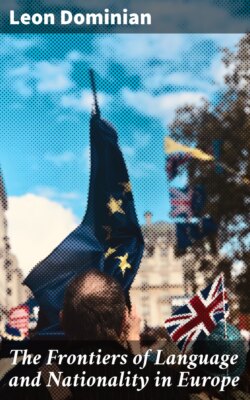Читать книгу The Frontiers of Language and Nationality in Europe - Leon Dominian - Страница 12
На сайте Литреса книга снята с продажи.
FOOTNOTES:
ОглавлениеTable of Contents
[24] H. Witte: Forsch. z. deut. Landes- u. Volkeskunde, Vol. 10, 1897, No. 4, pp. 299–424.
[25] L. Gallois: Les limites linguistiques du Français, Ann. de Géogr., Vol. 9, 1900, p. 215.
[26] P. Langhans: Sprachen Karte von Deutsch-Lothringen, 1:2,000,000, Deutsche Erde, 1909, Pl. 3.
[27] Das deutsche Sprachgebiet Lothringen und seine Wandelungen, etc., Forsch. z. deut. Landes- u. Volksk., Vol. 8, 1894, pp. 407–535.
[28] Translation: By the love of God and that of Christian people and of our common salvation, from this day on, in so far as God shall grant me knowledge and power, I will support my brother Karl, here present, by every manner of help, as one must, in duty bound, support one’s brother, provided he acts in the same manner with me; neither will I ever make agreements with Lothaire which, through my own will, shall prejudice my brother Karl here present.
[29] Anthropologic data for the southwestern section of Alsace are instructive. The generation of a transition type between the short and sturdy Alpine type and the “sesquipedal” Teuton is observable. Cf. Ripley: The Races of Europe, New York, 1899, pp. 225–226.
[30] The name has been traced to the generic meaning of forest through its consonants v-s-g, which are convertible into b-s-k, the latter corresponding to bosquet, busch, bush, etc. Cf. J. C. Gerock: Die Benennung und Gliederung des linksrheinischen Gebirges, M. Philomath. Ges. Elsass-Loth., Vol. 4, 1910, pp. 251–274.
[31] R. Blanchard: Deux grandes villes françaises, La Géogr., Vol. 30, Nos. 2–6, 1914, pp. 120–121.
[32] The Statesman’s Yearbook, 1915, p. 972.
[33] J. B. Masson: Die Siedelungen des Breuschtals Elsass, Monatschrift Gesch. u. Volksk., 1910, pp. 350–373 and 479–498.
[34] Zur Geschichte des Deutschtums in Elsass und im Vogesengebiet, Forsch. z. deut. Landes- u. Volksk., Vol. 10, No. 4, 1897.
[35] H. Witte: Romanische Bevölkerungsrückstände in deutschen Vogesentälern, Deutsche Erde, Vol. 6, 1907, pp. 8–14, 49–54, 87–91.
[36] DuMont Schanberg: Die Bevölkerung Elsass-Lothringen nach den Ergebnissen der Volkszählung vom 1 Dezember 1905 an der Früheren Zählungen. Stat. M. über Elsass-Lothringen, Vol. 31, Stat. Bur. f. Elsass-Lothringen, Strassburg, 1908.
[37] After the language map of Alsace-Lorraine in Andree’s Handatlas, pp. 67–68, 6th ed.
[38] After Gallois’ map, Ann. de Géogr., Vol. 9, 1900, Pl. 4.
[39] P. Langhans: Die Westschweiz mit deutschen Ortsbenennung, 1:500,000, Deutsche Erde, Vol. 5, 1906, Pl. 5.
[40] E. Gallois: Les limites linguistiques du Français, Ann. de Géogr., Vol. 9, 1900, p. 218.
[41] P. Clerget: La Suisse au XXme siècle, Paris, 1908, p. 55.
[42] L. Courthion: Le front des langues en Suisse, Mercure de France, Vol. 112, No. 420, Dec. 1, 1915, pp. 636–646.
[43] J. Brunhes: La géographie humaine, Paris, 1912, pp. 599–601.
[44] The French-speaking population of the Valais is estimated at 70 per cent of the inhabitants of the canton.
[45] M. L. Poole: Historical Atlas of Modern Europe, Oxford, 1902, Pl. 44.
[46] Introduction à l’étude comparative des langues indo-européennes, Paris, 1915.
[47] Graphisch-statistischer Atlas der Schweiz, Bureau des eidgen. Departements des Innern, Berne, 1914, Taf. 7.
